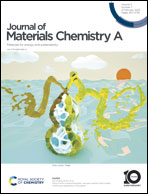Atomic layer deposition for surface area determination of solid oxide electrodes†
Abstract
Surface area measurements are important for characterizing porous solids, but commonly used methods such as Brunauer–Emmett–Teller (BET) gas adsorption and computed nanotomography are lacking for certain applications such as the development of solid oxide fuel cell electrodes, which often have absolute surface areas <1 m2 and contain nanoscale features. Presented is a novel method for the surface area determination of samples with total measurable areas of 1–1000 cm2 with a standard deviation ± 1 cm2, utilizing the atomic layer deposition (ALD) of Al2O3 over microstructurally complex internal porosity. The volume of alumina is then quantified using plasma spectroscopy and converted to an area using the known ALD layer thickness. Under the modest ALD reactor soak times used (8.5 s), the precursor penetration depth is found to be ∼50 μm, exceeding the requirement for uniformly coating SOFC functional layers. A model system, (La0.8Sr0.2)0.98MnO3−δ/Ce0.9Gd0.1O1.95 (LSM/GDC) scaffolds of ∼2.7 m2 g−1, was measured using the technique and compared against the BET method, and comparable results were obtained but with 1000 times less material needed. The technique is demonstrated for measurements in two example areas of active SOFC research: exsolved (Ni, Fe) nanoparticles on an Sr(Ti, Fe, Ni)O3−δ electrode and PrOx catalyst nanoparticles infiltrated onto LSM/GDC scaffolds. The technique may be broadly useful wherever the accurate surface area determination of small absolute quantities of porous ceramic structures on the order of 0.1–50 m2 g−1 is sought.



 Please wait while we load your content...
Please wait while we load your content...